大学英语词汇学习与教学策略研究
- 格式:pdf
- 大小:227.91 KB
- 文档页数:3
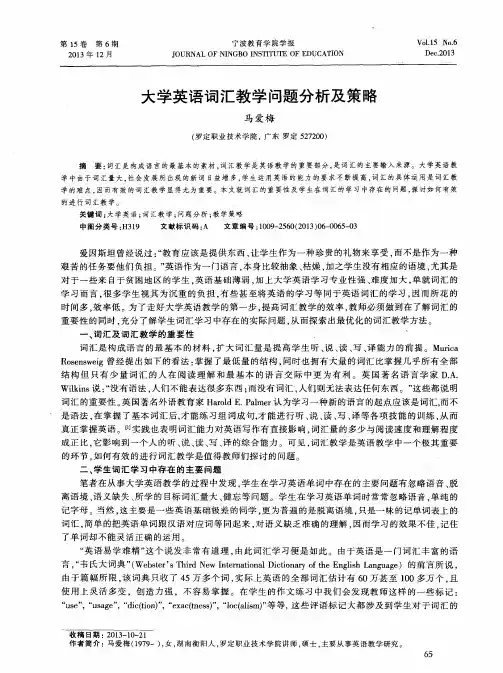
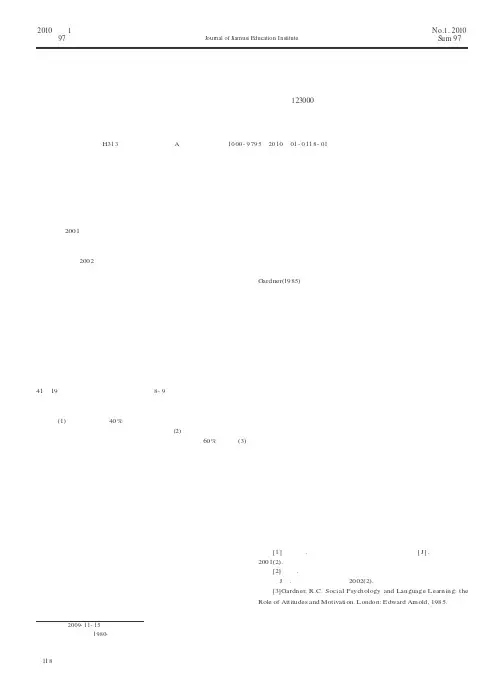
佳木斯教育学院学报J ournal of J iamus i Education Ins titute2010年第1期总第97期No.1.2010Sum 97大学生英语词汇学习情况浅析王雪芹(辽宁工程技术大学辽宁阜新123000)摘 要:词汇是语言习得的关键步骤。
在外语学习的课堂,可以通过对学生进行适当的词汇练习来培养学生的兴趣和自信心,加强课堂内的互动。
本文浅谈并探讨了可以融入外语词汇课堂教学中的各种方法。
关键词:词汇;语言习得中图分类号:H313文献标识码:A 文章编号:1000-9795(2010)01-0118-01收稿日期:5作者简介:王雪芹(),女,硕士,讲师,从事英语语言学及教育学方向研究。
一、在校大学生单词识记策略现状研究分析英语词汇习得是英语学习的一个重要组成部分,是一切语言技能的关键所在。
虽然部分学者意识到词汇习得的重要性,也进行了一些研究,但这些研究存在着很多局限性和不足。
词汇是语言不可缺少的一部分,语言教学不可能离开词汇教学。
因此对词汇现状的研究也日益重要起来。
国内外不少专家对词汇学习的理论性和和其相关的记忆策略进行了详细的研究,并取得了显著成果。
例如国内马广惠(2001)对理工科大学生英语词汇水平做的多层面、多因素的研究,表明学生的领会词汇水平与大纲存在较大差距,使用词汇水平基本接近大纲要求,女生显著高于男生,年龄与词汇水平呈反比。
而邵华(2002)针对普通高师院校非英语专业学生做了类似研究,结果发现学生四级词汇水平与大纲要求差距较大,女生显著优于男生,汉语水平、年龄与词汇水平呈零相关。
这些研究成果为理解大学生词汇现状提供了依据,但也存在一定的局限性。
现在的四、六级考试对学生形成正确的学习方法有很大的冲击,为了过四、六级,学生单纯的背诵四、六级单词词汇表,导致其最终不会用而且一用就错,感觉单词见过,但是在写作和听力中却写不出来、听不出来,无法学以致用。
现在在大学英语课堂教学中,教师往往注重讲解词汇,却将词汇教学和语境分离开来,出现了教学效果与预期值相悖的现象。
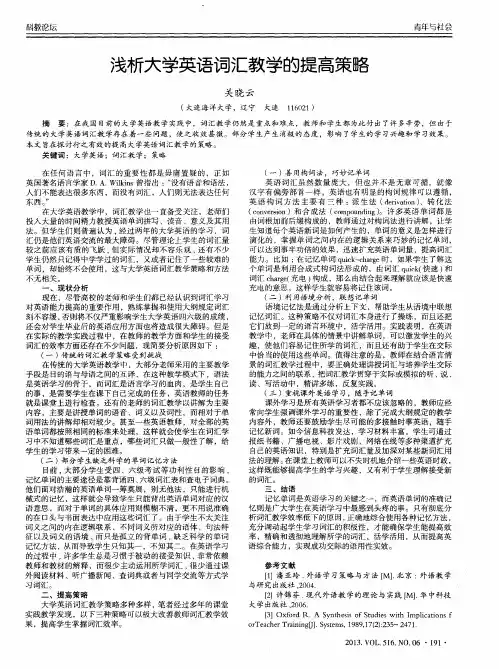
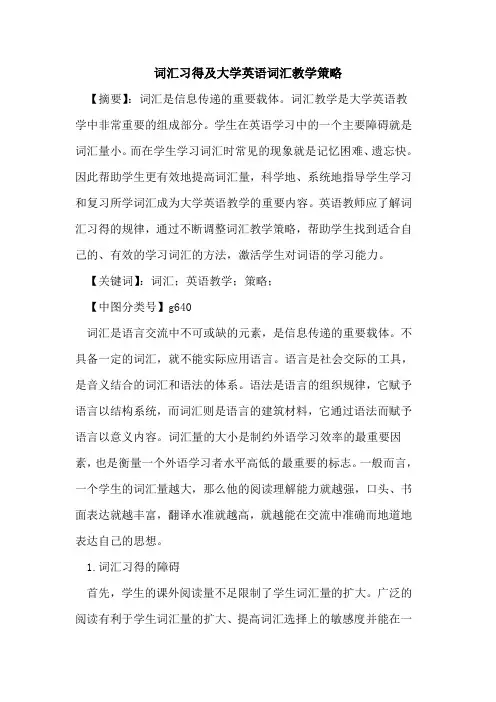
词汇习得及大学英语词汇教学策略【摘要】:词汇是信息传递的重要载体。
词汇教学是大学英语教学中非常重要的组成部分。
学生在英语学习中的一个主要障碍就是词汇量小。
而在学生学习词汇时常见的现象就是记忆困难、遗忘快。
因此帮助学生更有效地提高词汇量,科学地、系统地指导学生学习和复习所学词汇成为大学英语教学的重要内容。
英语教师应了解词汇习得的规律,通过不断调整词汇教学策略,帮助学生找到适合自己的、有效的学习词汇的方法,激活学生对词语的学习能力。
【关键词】:词汇;英语教学;策略;【中图分类号】g640词汇是语言交流中不可或缺的元素,是信息传递的重要载体。
不具备一定的词汇,就不能实际应用语言。
语言是社会交际的工具,是音义结合的词汇和语法的体系。
语法是语言的组织规律,它赋予语言以结构系统,而词汇则是语言的建筑材料,它通过语法而赋予语言以意义内容。
词汇量的大小是制约外语学习效率的最重要因素,也是衡量一个外语学习者水平高低的最重要的标志。
一般而言,一个学生的词汇量越大,那么他的阅读理解能力就越强,口头、书面表达就越丰富,翻译水准就越高,就越能在交流中准确而地道地表达自己的思想。
1.词汇习得的障碍首先,学生的课外阅读量不足限制了学生词汇量的扩大。
广泛的阅读有利于学生词汇量的扩大、提高词汇选择上的敏感度并能在一定程度上促进学生对词汇的理解和运用。
阅读量的多少直接决定词汇量的大小。
只有在英语阅读达到一定的量时,才能实现一定的词汇输入量,学生的词汇量也才能相应扩大。
目前学生普遍存在阅读量有限的问题。
很多学生的阅读材料仅局限于课本和测试卷。
其次,很多同学记忆单词的主要目的是应付大学英语四级、六级考试,功利性较强。
如此功利地为背单词而背单词,只会割裂了单词这一构成语言的最基本要素之间的内在联系。
再次,大多数学生学习和记忆词汇时不讲究学习策略,不善于使用高效记单词的方法,比如构词法、联想法等等,致使在记单词时耗时多,效果差。
最后,很多同学没有定期复习所学的新词。
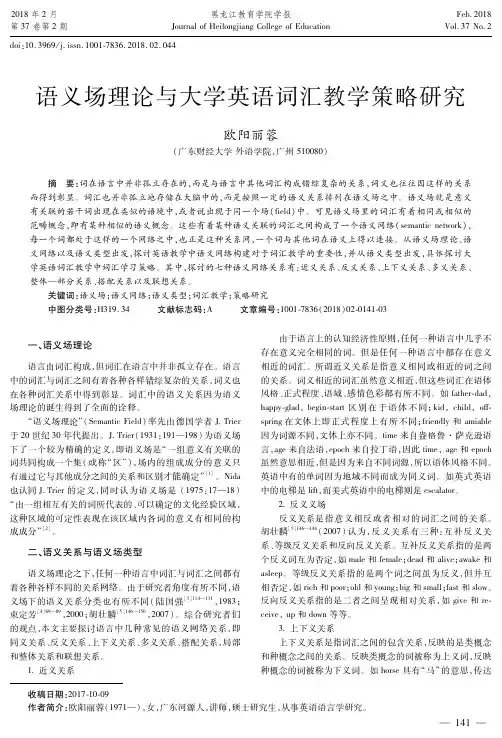
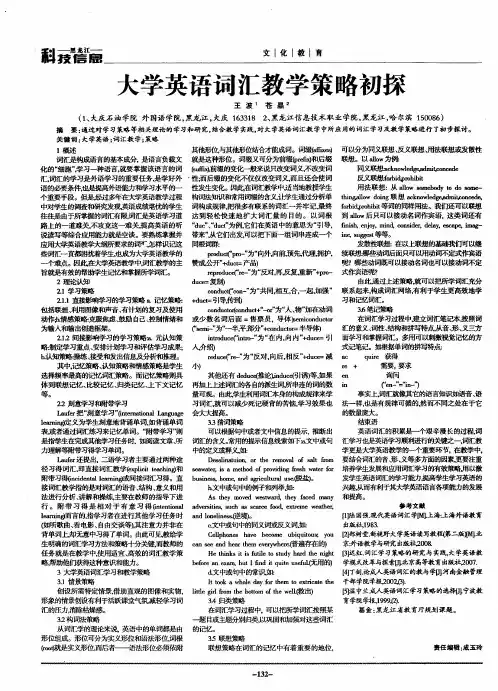
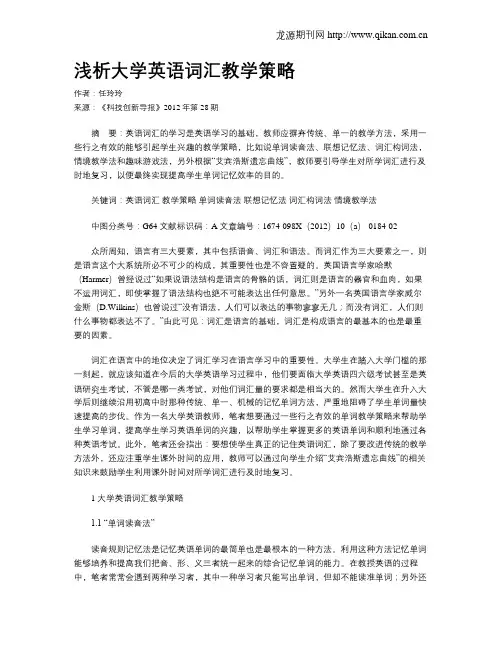
浅析大学英语词汇教学策略作者:任玲玲来源:《科技创新导报》2012年第28期摘要:英语词汇的学习是英语学习的基础,教师应摒弃传统、单一的教学方法,采用一些行之有效的能够引起学生兴趣的教学策略,比如说单词读音法、联想记忆法、词汇构词法,情境教学法和趣味游戏法,另外根据“艾宾浩斯遗忘曲线”,教师要引导学生对所学词汇进行及时地复习,以便最终实现提高学生单词记忆效率的目的。
关键词:英语词汇教学策略单词读音法联想记忆法词汇构词法情境教学法中图分类号:G64 文献标识码:A 文章编号:1674-098X(2012)10(a)-0184-02众所周知,语言有三大要素,其中包括语音、词汇和语法。
而词汇作为三大要素之一,则是语言这个大系统所必不可少的构成,其重要性也是不容置疑的。
英国语言学家哈默(Harmer)曾经说过“如果说语法结构是语言的骨骼的话,词汇则是语言的器官和血肉,如果不运用词汇,即使掌握了语法结构也绝不可能表达出任何意思。
”另外一名英国语言学家威尔金斯(D.Wilkins)也曾说过“没有语法,人们可以表达的事物寥寥无几;而没有词汇,人们则什么事物都表达不了。
”由此可见:词汇是语言的基础,词汇是构成语言的最基本的也是最重要的因素。
词汇在语言中的地位决定了词汇学习在语言学习中的重要性。
大学生在踏入大学门槛的那一刻起,就应该知道在今后的大学英语学习过程中,他们要面临大学英语四六级考试甚至是英语研究生考试,不管是哪一类考试,对他们词汇量的要求都是相当大的。
然而大学生在升入大学后则继续沿用初高中时那种传统、单一、机械的记忆单词方法,严重地阻碍了学生单词量快速提高的步伐。
作为一名大学英语教师,笔者想要通过一些行之有效的单词教学策略来帮助学生学习单词,提高学生学习英语单词的兴趣,以帮助学生掌握更多的英语单词和顺利地通过各种英语考试。
此外,笔者还会指出:要想使学生真正的记住英语词汇,除了要改进传统的教学方法外,还应注重学生课外时间的应用,教师可以通过向学生介绍“艾宾浩斯遗忘曲线”的相关知识来鼓励学生利用课外时间对所学词汇进行及时地复习。
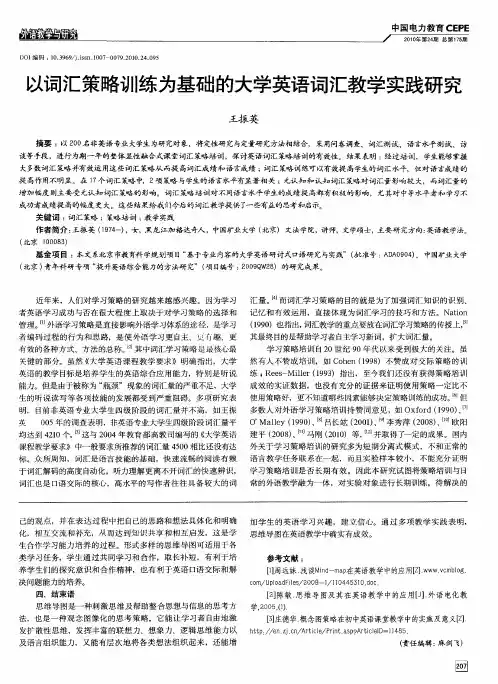

33关于大学英语词汇习得策略的研究张蓓蓓(兰州交通大学外国语学院甘肃兰州730070)摘 要:词汇习得是外语学习中的一个重要环节,然而不少学生都感到学习词汇费时费力但却收效甚微。
针对这一情况,本文拟就如何提高学习词汇的效率,帮助学生把好词汇关方面进行了一些探讨,在对一些普遍存在的问题进行研究和分析的基础上,提出了相应的策略和方法,以期能够帮助外语学习者在深度上和广度上提高词汇能力。
关键词:词汇;大学英语;策略中图分类号:H313文献标识码:A 文章编号:1000-9795(2010)06-0331-02收稿日期:作者简介:张蓓蓓(),女,甘肃泾川人,从事外国语言学及应用语言学方向的研究。
基金项目:年度第二批全国基础教育外语教学研究资助金项目(WYZ YB 3)。
一、引言词汇向来是我国大学英语教学中的重点之一,长期以来,为提高我国大学英语的教学水平,国家教委不断地提高对大学英语四级词汇量的要求。
根据我国《大学英语教学大纲》的规定,学生必须“领会式掌握4000单词以及一定量的常用词组,其中复用式掌握的单词为2500”才能够达到英语四级水平。
2007年7月,国家教育部再次修订《大学英语课程教学要求》,其中大学阶段的英语教学要求被分为三个层次,即一般要求、较高要求和更高要求。
一般要求是高等学校非英语专业本科毕业生应达到的基本要求。
在一般要求中要求学生“掌握的词汇量应达到约4795个单词和700个词组(含中学应掌握的词汇),其中约2000个单词为积极词汇,即要求学生能够在认知的基础上在口头和书面表达两个方面熟练运用的词汇”。
由此可看出我国对大学英语词汇的要求正在逐步提高,这也就决定了一线教师应把教学重点进一步地放在扩展学生词汇量和提高学生词汇能力上。
针对这一情况,本文拟就如何抓好词汇教学方面进行一些探讨。
二、词汇在二语习得中的地位及词汇教学的重要性在外语学习中,词汇学习是一个重要的组成部分,没有词汇就没有语言。
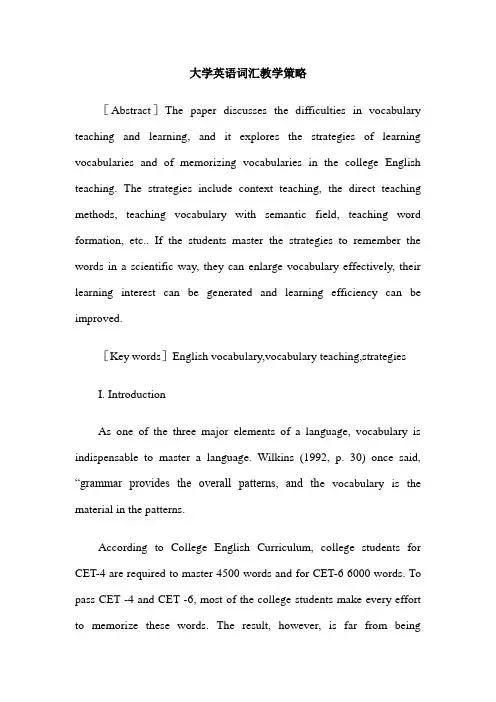
大学英语词汇教学策略[Abstract]The paper discusses the difficulties in vocabulary teaching and learning, and it explores the strategies of learning vocabularies and of memorizing vocabularies in the college English teaching. The strategies include context teaching, the direct teaching methods, teaching vocabulary with semantic field, teaching word formation, etc.. If the students master the strategies to remember the words in a scientific way, they can enlarge vocabulary effectively, their learning interest can be generated and learning efficiency can be improved.[Key words]English vocabulary,vocabulary teaching,strategiesI. IntroductionAs one of the three major elements of a language, vocabulary is indispensable to master a language. Wilkins (1992, p. 30) once said, “grammar provides the overall patterns, and th e vocabulary is the material in the patterns.According to College English Curriculum, college students for CET-4 are required to master 4500 words and for CET-6 6000 words. To pass CET -4 and CET -6, most of the college students make every effort to memorize these words. The result, however, is far from beingsatisfactory. Thus, how to improve English vocabulary teaching so as to achieve the vocabulary teaching task has become an urgent problem.Traditionally, there are three kinds of common practice in vocabulary teaching. Perhaps the most common way to teach vocabulary is by presenting the unfamiliar list of individual word items before the learners encounter the texts. Secondly, some teachers only ask their learners to memorize the word lists at the back of their course books without paying any attention to how they are used in real language contexts. What’s worse is that they cannot equip their learners with the ability to use the words correctly in their language production work. In order to solve these problems, this paper is drafted. This paper will illustrate some different strategies to help students master vocabulary, if students can use them in an effective and scientific way, they will remember vocabulary easily.Ⅱ. Previous Studies on English V ocabularyTeaching at HomeIt was not until 1980 that we Chinese began to research into language learning strategies. Wen Qiufang (1996, p. 66), in his book On English Learning Strategies, expands learning strategy system, the innate factors of the system as well as how to coordinate and control otherfactors affecting strategies selection.However, most of the current researches emphasize on theory analysis and only some of them deal with empirical research. Besides, some principles are unpractical in real teaching. Therefore, we need to gather experience in daily teaching class in order to improve the methods of teaching vocabulary.Ⅲ. The Problems of V ocabulary Learning andTeaching in College3.1 Low efficiency in mastering vocabularyEnglish learning and teaching are considered as “consuming more time but achieving less efficiency”. Allen (2000, p. 44) claims that teachers give little attention to methods to help students learn vocabulary. They spend plenty of time on remembering words, but they find it hard to remember vocabulary and easy to forget. Gradually, these students lose their interest in English because they find it hard to learn the words by heart.3.2 Putting more emphasis on grammarIn English class, teachers pay much attention to grammar. When analyzing a sentence, the teachers often concentrate on sentence ratherthan vocabulary. Teachers read the new words and point out its meaning in some text. Furthermore, the national college entrance examination tests basic knowledge, including grammar, tense, and count and so on. As a result, teachers spend more time teaching grammar than vocabulary in class.Ⅳ. The Strategies of College English V ocabulary Teaching4.1 Context teachingContext means the words that come just before and after a word, phrase or statement and help you to understand its meaning. Thus words should not be taught out of context. Moreover, context teaching caters to students for an effective reading and communication by making use of the words they have learnt. More importantly, context teaching helps cultivate students’good habits of reading between the lines. For example, in Unit1 of College English, Book 2, there is a sentence containing a new phrase: “That magazine story, and the person who wrote it, I have never been able to track down.” In light of the context, we can guess the meaning of “track down”, which means “find” or “discover.” Then let’s add one more example: “It was almost two weeks before the police tracked down the facts they needed.”4.2 The direct teaching methodThe Direct teaching method means teachers give a class directly, often by a kind of auxiliary teaching equipment, such as pictures, material object, PPT and gestures, expressions and so on.Harmer (2000, p. 55) said, “The teacher can also ensure that the students understand the meaning of a word by showing pictures (photographs, cards. etc).”For instance, when a teacher teaches a book, he can take an actual book, points out the book and says “book.” Then she takes another book and says “book” Students will understand “a book” is a book after teachers repeat “a book.” With the development of science and technology, the computer is a common teaching tool, so teachers can use PPT to show pictures to teach what a tree, bank, plane is.4.3 Teaching vocabulary with semantic fieldThe basic assumption underlying the theory of semantic field is that words do not exist in isolation: rather, they form different semantic fields, such as a vegetable field which contains all kinds of words that denote vegetables: spinach, cauliflower, cabbage, pepper, eggplant, onion, tomato, cucumber. Words that belong to the same semantic class are in the same semantic field. According to the theory of semantic field, the meaning of a word is decided by its relationships with other words in the same semantic field. There are various kinds of such sense relationships, for example, hyponymy, part/whole relationships, synonymy andantonymy. By association of words in the same semantic field, we can train our students to constantly deepen their recollection of words learnt and reinforce learning and retention of newly learnt words.4.4 Teaching word formationWord formation is an effective way to help students see words in the network of association. As McCarthy (2001, p. 87) puts it: to know the meaning of a word becomes the task of knowing its associations with other words. Therefore, to teach lexical items effectively, teachers must familiarize students with these common roots, prefixes, suffixes. For example, in teaching the word “transplant” students are told that the prefix transmits across; beyond; into another place or state. When they are aware of the meaning of organ (liver, kidney, heart) transplant, they are asked to tell the meanings of the following words with a given context: transport, transform, translate, transact, transfer, transit, transatlantic, transparent, translucent. While learning the word scribble, the root -scribe is taught first. It means to write.The most productive are affixation, compounding and conversion. According to Hogben and Lawson, (1993, pp. 145-147) words produced through affixation constitute 30﹪to 40﹪of the total number of new words; compounding yields 28% to 30% of all the new words; conversion brings 26﹪of the new vocabulary into modern English.4.5 Teaching usage of wordsLinguist Brown (2001, p. 34) points out: the word is only really acquired if the learner can use it actively and correctly, or has efficient recall of it in a variety of contexts. So our efforts to acquire a large vocabulary should never culminate in better comprehension. As we all know, the ultimate purpose of vocabulary development is to help learners to communicate effectively with these words learnt. Thus it is necessary for teachers to teach usage of words that is, to explain the collocations, to learn idioms, related proverbs and to distinguish synonyms.1. CollocationCollocation is a difficult but important part of vocabulary acquisition. Merely knowing the Chinese meaning of a word does not guarantee correct use of the word. Take a look at the following example. It is right to say “open the door”, “open fire”, but “open TV”, “open the light” or “open an operation” do not make much sense to a westerner. Instead, “turn on the TV”, “turn on the light”, “perform an operation” should be used.In teaching “ restrain”, if students are given the nouns and prepositions that go with it, they can have phrases like restrain one’stemper/anger/laughter, restrain sb from doing sth. In addition, they canhave the collocations of its noun form restraint: submit to restraint, break loose from all restraints, without restraints.2. IdiomsIdioms learning arouses students interest in learning new words, hence enhances their memory of these words. Take the idiom “let the cat out of the bag” as an example, students understand every word, but they have no idea about the meaning of the idiom. After given a context, they are able to know its meaning to tell a secret by a mistake. Thus students are taught not to be easily contented with merely knowing the individual word; they should learn idioms for better understanding.3. ProverbsProverbs in every culture are considered crystal of human wisdom. Making use of related proverbs in vocabulary teaching stimulates students’interest. Take the following proverbs as examples:A hedge between keeps friendship green. (similar proverb: good fences make good neighbor.)To err is human, to forgive is divine.Many kiss the baby for the nurse’s sake.A horse stumbles with four legs. (The italicized words are newwords to be learned.)Ⅴ. ConclusionThis thesis mainly discusses the strategies of vocabulary teaching, and of course, everyone realizes the importance of the vocabulary. Just as Wilkins once said, “without grammar, only a little information could be covered, without vocabulary, no information could be covered.” So, vocabulary is the key to language learning. However, learning vocabulary is not easy thing. In this thesis, it illustrates some problems which lie in vocabulary teaching and learning. In order to tackle these problems, the thesis puts forward some strategies, including context method, direct teaching method, semantic method, word formation method, and teaching usage of words.If students master these strategies, they will find it less difficult to master vocabulary than before. So, teachers should teach students how to learn instead of what to learn.【References 】[1]Brown, HD. 2001. Teaching by principle: An Interactive Approach to Language Pedagog[M].Foreign Language Teaching and Research Press.\[2\] Hamre, J. 2000. How to teach English[M].Foreign Language Teaching and Research Press.\[3\] Hogben, D, Lawson, M. J. 1993. Strategies for foreign language vocabulary acquisition[M].Western Australia: The Annual Conference of the Australia Association for Research in Education.\[4\] McCarthy, M. 2001. V ocabulary[M].Oxford: Oxford University Press.\[5\] Wen, Qiufang. 1996. On English learning strategies [M].Foreign Language Teaching Press.\[6\] Wilkins, D. A. 1997. V ocabulary linguistic in language teaching [M].London: Eduard Arnold Ltd..\[7\] Wilkins, D.A. 1997. National syllabuses[M].Oxford: Oxford University Press.[摘要]本文对大学英语词汇教法进行了探究,如:情景法、直观教学法、语义场法、构词法等策略。
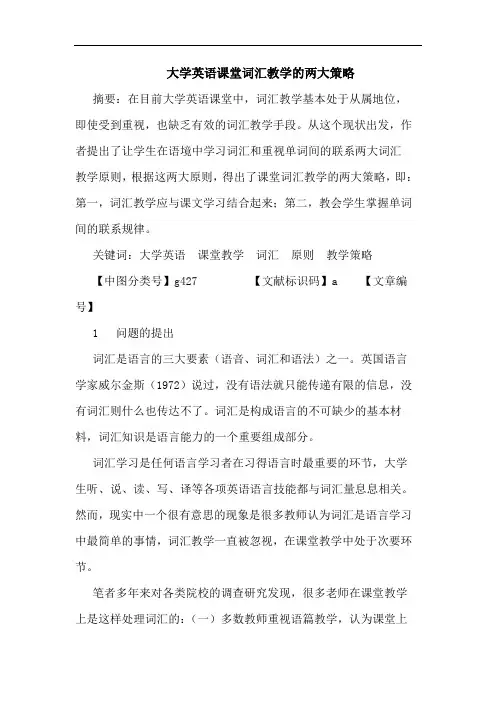
大学英语课堂词汇教学的两大策略摘要:在目前大学英语课堂中,词汇教学基本处于从属地位,即使受到重视,也缺乏有效的词汇教学手段。
从这个现状出发,作者提出了让学生在语境中学习词汇和重视单词间的联系两大词汇教学原则,根据这两大原则,得出了课堂词汇教学的两大策略,即:第一,词汇教学应与课文学习结合起来;第二,教会学生掌握单词间的联系规律。
关键词:大学英语课堂教学词汇原则教学策略【中图分类号】g427 【文献标识码】a 【文章编号】1 问题的提出词汇是语言的三大要素(语音、词汇和语法)之一。
英国语言学家威尔金斯(1972)说过,没有语法就只能传递有限的信息,没有词汇则什么也传达不了。
词汇是构成语言的不可缺少的基本材料,词汇知识是语言能力的一个重要组成部分。
词汇学习是任何语言学习者在习得语言时最重要的环节,大学生听、说、读、写、译等各项英语语言技能都与词汇量息息相关。
然而,现实中一个很有意思的现象是很多教师认为词汇是语言学习中最简单的事情,词汇教学一直被忽视,在课堂教学中处于次要环节。
笔者多年来对各类院校的调查研究发现,很多老师在课堂教学上是这样处理词汇的:(一)多数教师重视语篇教学,认为课堂上讲解词汇会割断语篇的连贯性,从而把词汇教学放在附属地位。
词汇学习基本上处于一种自学状态,缺乏教师的有效指导。
(二)大学英语词汇教学基本上是教师讲要点,学生记笔记,教师大量讲解词汇搭配、词语用法,单一的教学方式无法给学生提供理解、消化和体验学习过程的机会,学生也就感到枯燥、乏味。
(三)以阅读带词汇,缺乏必要讲解。
大学英语教学词汇教学是在阅读课上进行的。
这种方法对学生扩大词汇量有一定帮助,尤其是强化突击时有一定成效,但是因为没有注意向学生介绍构词知识,扩词技巧,培养学生独立分析词汇,扩展词汇的能力,最终效果不理想。
对于学生而言,背诵词汇的目的大多是为了应付考试,而且常常是死记硬背,结果是背得多,忘得多也忘得快。
即使记住了,也是记住了单词的表面意思和拼写方式,根本不知如何运用。
手机词汇APP在大学英语词汇教学中的应用与研究——以百词斩为例徐丹英语移动词汇学习软件是互联网时代新式自主词汇学习方式的产物。
将百词斩词汇学习软件作为辅助大学英语词汇教学的工具,经过一学期的教学实验后发现,基于手机的词汇APP可以有效激发学生学习兴趣,提高词汇学习效果。
一、引言词汇作为语言构成的基本要素,是语言教学的基础。
要想恰当地运用外语,就一定不能忽视充足的词汇量的掌握,否则语言的结构和功能不能恰当地得到表达和运用。
然而在大学英语教学中,词汇教学往往“耗时多收效小”,讲解过程乏味,缺少词汇学习策略指导和训练,词汇学习评价方式死板、单一等,导致词汇学习效果不佳。
移动学习是近年来随着通讯技术的快速发展与普及而出现的一种新型学习模式,在英语教学各领域得到迅速应用。
学习者可以随时随地学习,可以根据自己的知识程度、学习方式、学习能力选择相应的学习内容、呈现方式和制定学习计划等。
智能手机作为一种便携的移动终端设备,因其携带方便、操作灵活、上网方便等优势大大增加了移动学习的可能性,保证了学习者学习个性化的需求和学习自主化的驱动。
移动终端的各种英语学习软件,图文并茂,声像俱备,贴近生活,有着传统教学无法比拟的移动性、生动性和人性化的设计。
手机词汇APP就是针对单词学习应运而生的一种内容丰富,界面清晰,易操作的,安装在移动设备上的应用程序,如:百词斩、开心词场、完美规划、扇贝等,受到很多词汇学习者的青睐,也为学习者提供了新的词汇学习方式。
本研究旨在通过使用词汇学习软件作为大学英语词汇教学的辅助工具,探讨大学英语词汇教学的新方法和新模式,以期改善和提高词汇学习者的学习效果,同时为“互联网+”时代背景下的大学英语教学研究和改革提供一定的参考。
二、实验研究1.研究目的本文尝试使用“百词斩”作为词汇学习辅助软件,以大学英语课堂为载体,从教师和学生的双重角度出发,通过教学实验、问卷调查和访谈,探讨使用手机词汇软件提高学生词汇学习的策略和方法,以期改善和提高词汇学习者的学习效果和质量,并为大学英语词汇教学提供一些建议和启示。
浅谈英语学习中词汇记忆的策略摘要:英语学习过程中最困难的问题就是词汇学习,通过对词汇记忆策略的分析,探讨词汇记忆策略与词汇习得的相关性,对掌握词汇学习的技巧有一定的帮助作用。
关键词:英语学习;英语词汇;记忆策略问题的提出对于大多数中国学生而言,学习英语费时低效,且在学习英语过程中遇到的一个主要问题就是词汇学习。
长期以来,人们认为学习词汇就是背词汇表,关于词汇教与学的研究却很少。
20世纪60年代以后,西方学者开始关注英语词汇记忆方法,主要围绕两个方面展开讨论:重复策略和编码策略(指关键词记忆法和联系法)。
不少英语语言学者在这方面做了很多研究。
Parry,Luppescu和Day等研究了阅读、查字典与词汇学习之间的关系,他们认为广泛地阅读有益于词汇质的提高和量的扩大。
Krashen也主张通过广泛阅读自然习得单词,不鼓励采用机械式的记忆方法。
虽然大多数中国学生已逐渐接受了词汇不能靠死记硬背,应在上下文中和通过运用来习得,但在学习过程中却仍然靠死记硬背。
原因何在?笔者认为主要有三方面的原因。
原因分析1.传统语言学习方法的影响背诵是我国传统的学习语言的方法。
古人学习汉语就是从背诵诗文开始的,所以才有“熟读唐诗三百首,不会做诗也会吟”的说法。
背诵在现代汉语教学中仍占重要地位,并且迁移到了外语教学。
在小学或者初中学习外语时,背单词,背句型,背课文是学生的一大任务,也是主要的英语学习策略之一。
并且不乏有资深英语教师声称,“要学好英语就得背”,这样的英语学习价值取向直接影响到学生的英语学习方法,于是背诵和机械记忆成为大多数学生学习英语最重要的方法。
因此,对于习惯了背单词的学生来说,“自然习得”的方法就难以适应了。
2.特定语言学习环境的制约Kachroo研究发现,要成功地记住一个生词,学生至少得连续遇到7次。
而Saragi. T则指出不断地碰到一个单词16次后,学生才能自然地记住它。
可见想要自然习得单词,就必须有一个能大量阅读的学习过程,这样,学生才能在一定时间内频繁地遇到同一个单词,从而自然地记住它。